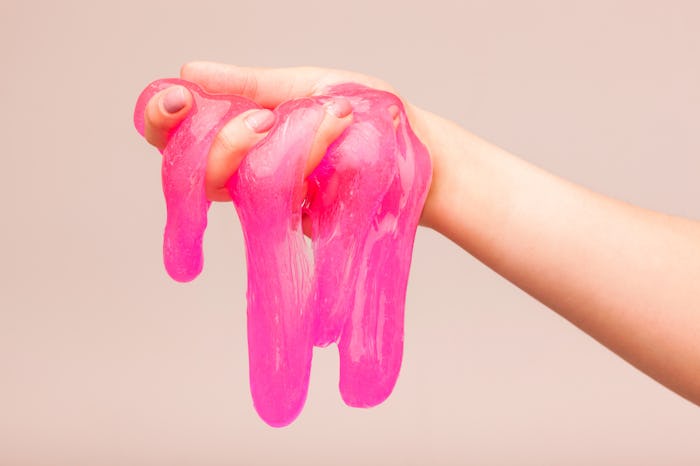Kids and messy substances go together like, well, sticky peanut butter and globby jelly. From the moment babies discover what happens when their fingers accidentally slip into a bowl of strained green beans, they find every opportunity they can to coat their hands with stuff. Does it ooze, drip, splatter, stretch, squish, or smear? Bring it on! That's why the slime trend is still going strong among the elementary and middle school sets. It's also why we parents need to know how to fix melted slime when our kids come to us wailing for help.
I know this from personal experience. My daughter has been obsessed with slime ever since it became the school DIY of the moment. She's also well-versed in every slime recipe, thanks to the YouTube experts who get millions of views on their channels just for filming themselves mixing up colorful, glittery glop. (Did you know that young slime guru Karina Garcia has turned her passion into a successful business? Think about that the next time you scrape your kids' used slime off the dining room table.)
But making slime isn't as easy as it sounds; the recipes call for precise proportions of ingredients. Too much glue or too little play clay can result in disaster. I tried making it myself for my pre-K class's sensory table during our Dr. Seuss unit, and instead of a nice, stretchy mass, I ended up with a sticky, finger-adhering mess that even the 5-year-olds didn't want to touch after a while.
Judging by the number of visits and likes on all the "Slime Hacks" videos, I'm not the only one who finds it tough to get the goo just right. One of the biggest problems slime-makers face is melting, when the ingredients break down and turn from solid to liquid. When that happens, it's just a matter of adding back a substance that will stiffen it up again.
Here are some suggested fixes from the experts:
1Liquid Laundry Starch
Every slime recipe has an ingredient that acts as an "activator" — that is, creating a chemical reaction that binds the other ingredients together into the desired stretchy texture. Liquid laundry starch such as Sta-Flo is a popular slime activator. YouTube's Courtney Lundquist, whose slime hack video has nearly 1.2 million views, recommends adding extra starch to your melted slime mix, a little at a time, and stirring until the slime is back to its sticky self.
2Shaving Cream
If your kids leave their slime outside — especially on a hot summer day — it may separate, leaving a hard crust on top and a melted, gooey mess underneath. Rebecca Zamolo, another popular YouTube slime maker, has the solution: Squirt in some foamy shaving cream, like Barbasol. The chemicals in the cream will soften the crust while stiffening the melted portion, resulting in the pliable blob we all know and, um, love.
3Borax
Slime master andreaXandrea assures her YouTube audience that "there's no slime that can't be fixed." She explains that many glue-based slimes break down over time and revert to their liquid form (as you may have discovered if you've ever ordered slime online). Andrea's go-to: a solution of a half-teaspoon of borax dissolved in one cup of hot water. Add it a little at a time to the slime until it solidifies to the texture you want. If you're concerned about the safety of your kids handling borax, you may want to make the mixture yourself.
4Clear Glue
Andrea also notes that slime left out a month or more is likely to go totally liquid. To fix it, she recommends stirring in a little liquid clear glue to help bond the mixture together again, and then adding the borax solution if needed.
5Liquid Laundry Detergent
The bottle you already have near your washing machine is another hardening ingredient for non-borax-based slime, according to WikiHow. Again, add it a little at a time till the slime firms up.
6Toothpaste
A simple non-glue slime recipe also comes courtesy of WikiHow, for those days when you just don't want to spend your day scraping dried glue off your kids' hands. All you need is two tablespoons of shampoo and a teaspoon of toothpaste, with food coloring if desired. Mix together and freeze for 10 minutes to an hour, checking frequently and taking it out when the mixture is pliable but not rock-hard. Since the toothpaste acts as a hardener, add some more if your slime is too drippy.
